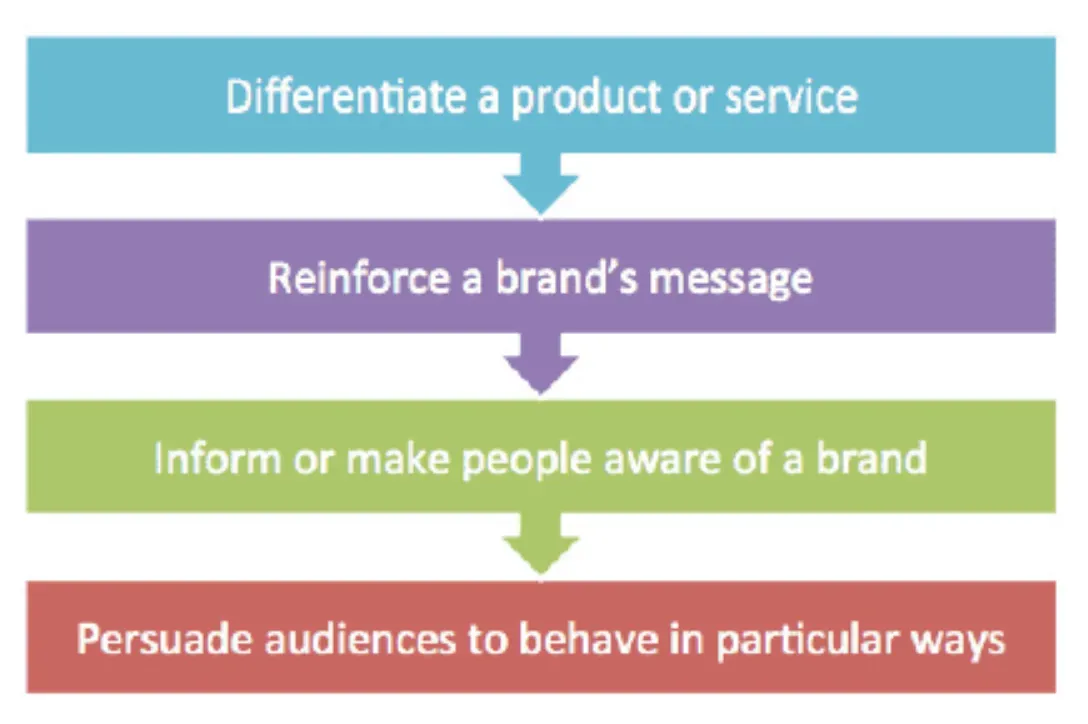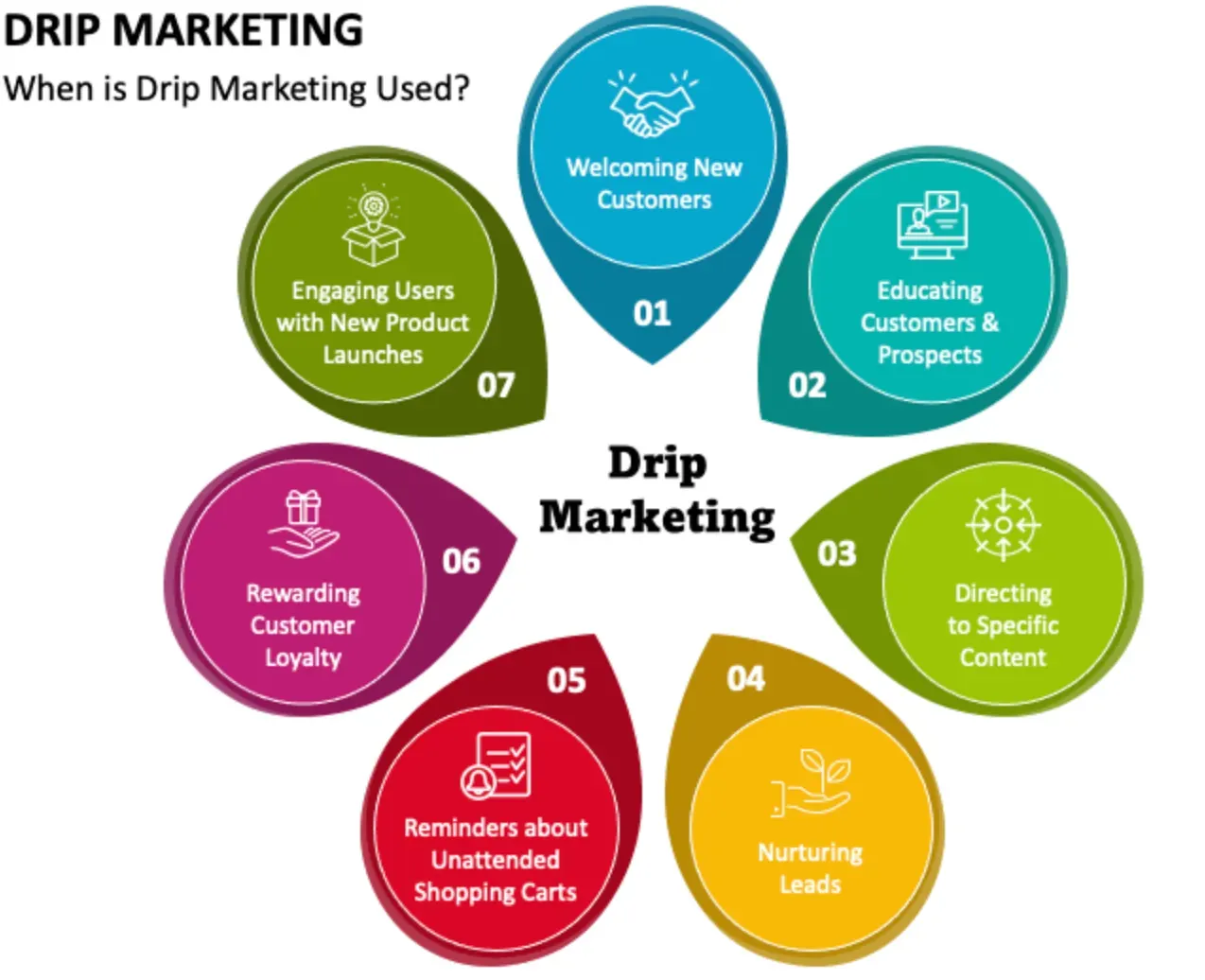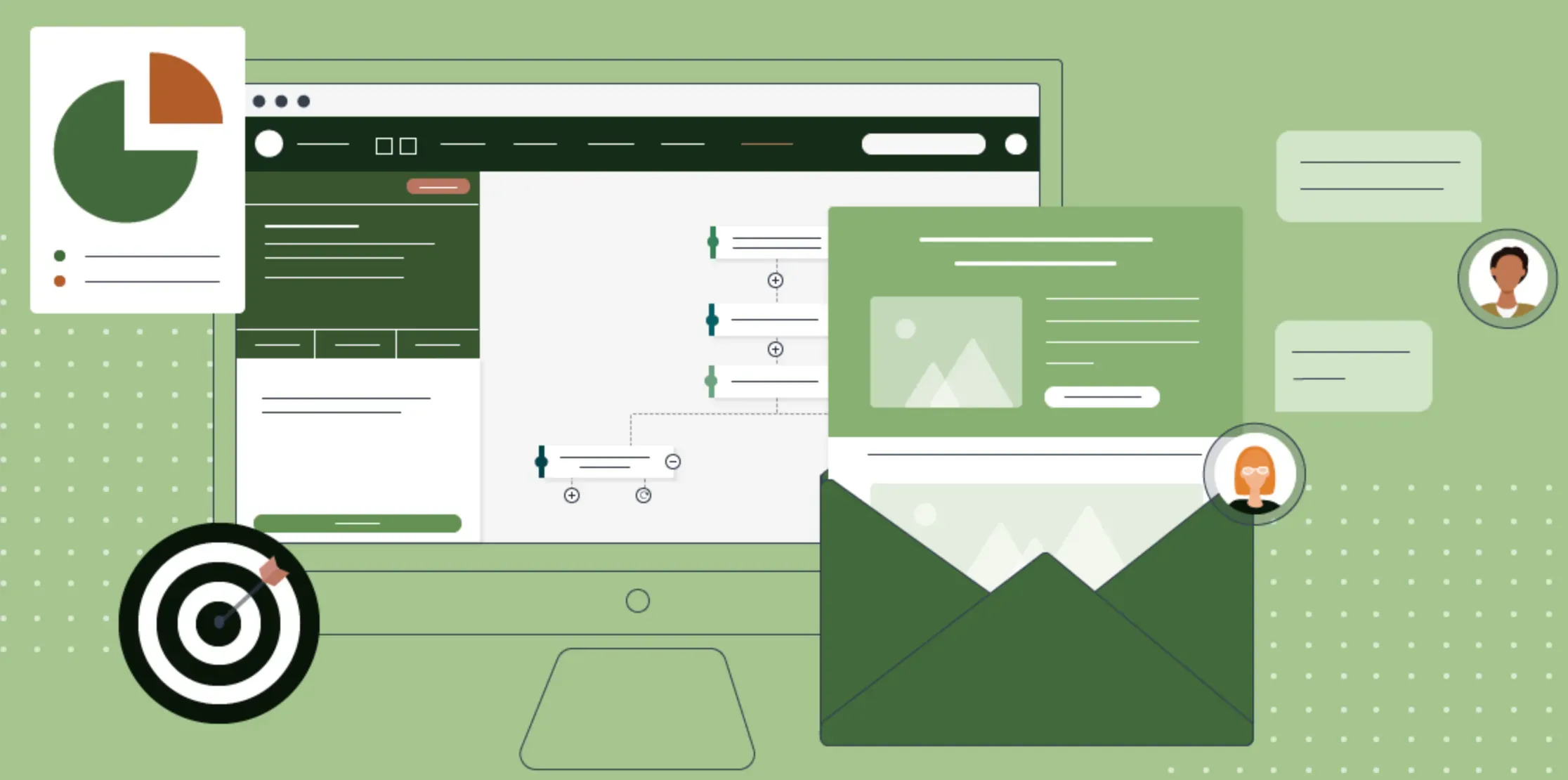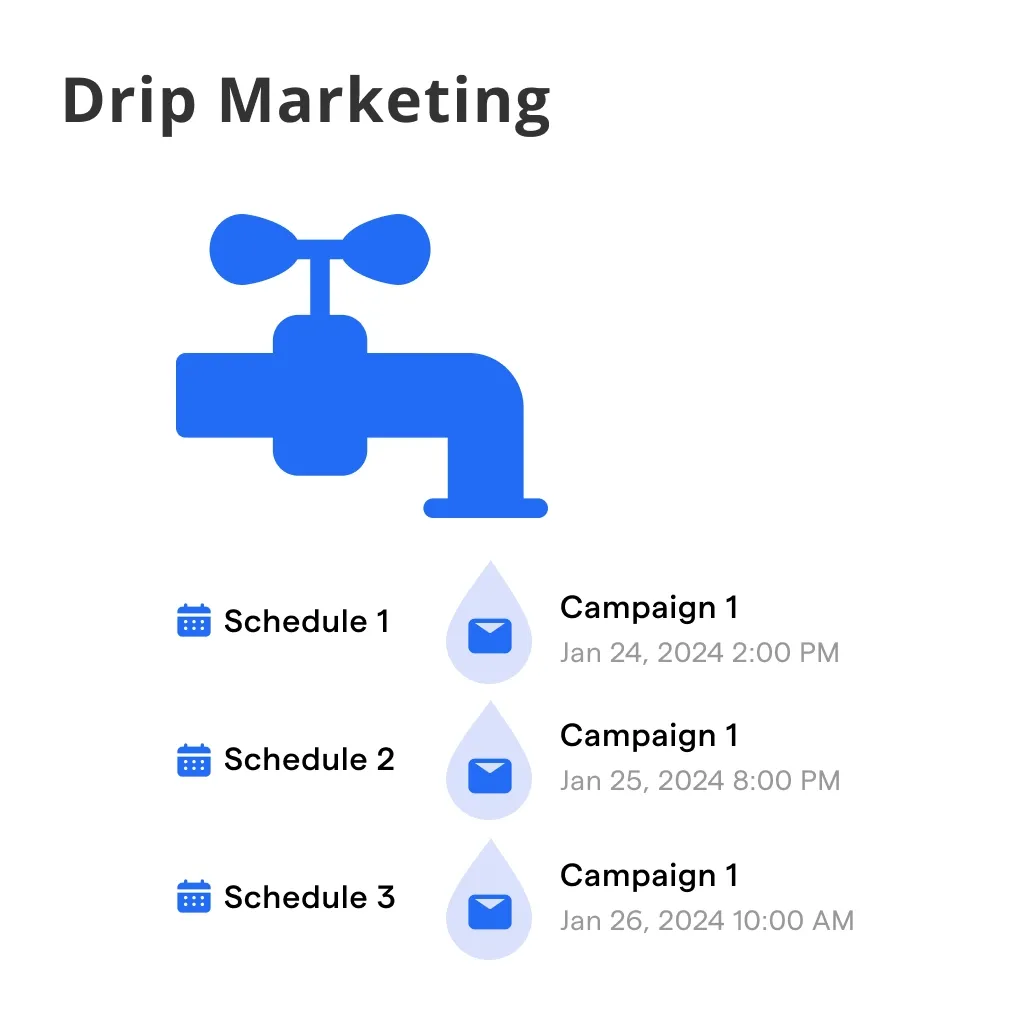What is Drip Marketing?
It's only substantial that we commence by defining drip marketing. Drip marketing is a communication strategy that sends, or "drips," a pre-written set of messages to customers or prospects over time. These messages often take the form of email marketing, although they can also involve other marketing channels.
Importance of Drip Marketing
Drip marketing is essential because it allows businesses to maintain a consistent presence in the minds of prospects while being cost-effective. It's particularly relevant in lead nurturing strategies and conversion optimization.
Components of Drip Marketing
Drip marketing involves sending messages to prospects and customers based on specific timelines or behavioral triggers. A successful drip campaign typically involves planning, setting up triggers, creating the content, and evaluating the campaign's performance.
Drip Marketing vs. Traditional Marketing
While traditional marketing usually involves one-off communications, drip marketing involves repeated messages over time. This helps reinforce the marketing message and engages customers more effectively.
Drip Marketing Tools
Several tools and software platforms can automate the process of drip marketing. These tools typically include email marketing automation, CRM, and personalized outreach options.
Why is Drip Marketing Important?
In this section, we’ll delve into the importance of drip marketing for businesses.
Lead Nurturing
Through its consistent and personalized messages, drip marketing helps ensure potential leads do not "turn cold" and helps in moving them through the sales funnel.
Customer Conversion
By engaging the customers at the right time with the right content, drip marketing serves as a great tool for conversion rate optimization.
Customer Retention
Drip marketing helps improve customer retention and loyalty by staying at the top of customers' minds, and delivering regular value via content.
Building Trust
By providing valuable content over time, rather than a hard sell, drip marketing can build trust with potential customers.
Better Open and Click Rates
Drip emails, due to their relevant and timely nature, tend to have better open and click rates, enhancing marketing effectiveness.
How Does Drip Marketing Work?
Let's now examine how drip marketing actually unfolds.

Planning the Drip Campaign
The first step involves identifying the goal, target audience, and the appropriate marketing channel. It also involves devising the content strategy for the campaign.
Setting Up Triggers
The next step involves setting up triggers depending on user behavior or a predetermined timeline.
Creating the Content
The content for drip campaigns usually spans different formats. This isn’t just limited to emails but can include informative blog posts, videos, webinars, or user guides.
Launching the Campaign
After content creation, comes the campaign's launch, where your messages start landing in the prospect's inbox or preferred communication channel.
Analyzing the Campaign
Following the launch, monitoring key metrics and analyzing the impact help to measure the campaign's effectiveness and adjust the strategy if needed.
Who Can Benefit from Drip Marketing?
Both large and small businesses can reap the benefits of drip marketing, let's get into the specifics.
B2B Enterprises
B2B businesses can use drip marketing to nurture leads, particularly for products or services with longer sales cycles.
B2C Businesses
For B2C businesses, drip marketing is great for customer retention, upselling, and maintaining customer loyalty.
E-commerce Platforms
E-commerce platforms can enhance customer engagement and drive purchases through personalized drip campaigns.
SaaS Businesses
Software-as-a-Service (SaaS) businesses often use drip marketing to onboard users, make product announcements, and reduce user churn.
Email Marketers
Drip marketing is a vital tool for email marketers to keep their subscribers engaged, interested, and updated.
When to Use Drip Marketing?
Knowing when to use drip marketing will ensure optimal results. Here's a focus on when it's best to use it.

Onboarding New Users
A welcome drip can help engage new users, familiarize them with your product, and lead to higher retention rates.
Following up on Website Visitors
Use drip marketing to keep the conversation open with visitors who expressed interest by engaging with your site, e.g., downloading a free resource, making a purchase, or signing up for a newsletter.
Re-engaging Inactive Users
For customers who've gone dormant, a re-engagement drip can be the reminder they need to come back and make a purchase.
Upselling or Cross-Selling
Educate your customers about other offerings or upgrades through an upsell or cross-sell drip.
Seasonal Moments
If you have offerings that align with particular seasons or events, a seasonal drip targeting those moments can be very effective.
Best Practices for Drip Marketing
Now that we've established the basics, let's examine the best ways to leverage this powerful marketing strategy.
Segment Your Audience
Group your prospects based on their behaviors, demographics, preferences or interaction with your brand to deliver more personalized and relevant messages.
Personalize Your Messages
Use customer data to personalize your communications for higher effectiveness. This isn't just limited to addressing them by their first name but also tailoring the content that best suits their needs.
Test Different Variations
A/B testing different variations of your campaign will help you identify what works best with your audience and optimize your strategies accordingly.
Use Multiple Channels
Diversify your approach by extending your drip campaign beyond emails. Consider options like SMS, retargeting ads, or even direct mail depending on your target audience.
Monitor and Tweak Your Campaigns
Continuously monitor your campaign performance and make necessary adjustments to improve effectiveness. Key metrics to watch out for include open rates, click-through rates, bounce rates, and conversion rates.
Challenges in Drip Marketing
Though powerful, drip marketing does have its hurdles. Here's what they typically are.

Message Timing
Striking the right balance in the frequency of messages without overwhelming the customer can be a challenge.
Personalization
While personalization enhances campaign effectiveness, its implementation can be tricky and resource-intensive.
Measuring Success
Setting up the right metrics to measure the success of your drip campaigns can be a challenge without the correct tools or understanding of what to track.
Managing Subscribers' List
Keeping your subscribers' list up-to-date and segmenting it accurately for targeting each group with the right content is often complicated and time-consuming.
Content Creation
Creating engaging, relevant, and timely content, especially for multiple groups of audiences, can pose a challenge.
Trends in Drip Marketing
Emphasizing the evolving nature of drip marketing, let's look at some current trends.
Using AI for Personalization
Artificial Intelligence and machine learning are increasingly being used for better personalization, which significantly boosts the success of drip campaigns.
Cross-Channel Drip Campaigns
Businesses are using multiple channels for their drip campaigns to reach customers wherever they are most active.
Value-Driven Content
There is a shift from persuasive selling to offering value-driven content which helps to build stronger relationships with customers.
Using Big Data
With big data, businesses can better understand customer behavior and plan their drip campaigns to correspond with individual customer journeys.
Interactive Emails
Interactive emails with elements like GIFs, videos, and clickable elements are becoming popular in driving customer engagement.
Frequently Asked Questions (FAQs)
How Does Drip Marketing Enhance Customer Engagement?
Drip marketing, by sending consistent, relevant content, keeps your brand top-of-mind for consumers, enhancing their engagement over time.
Can Drip Marketing Improve Customer Retention?
Yes, by providing customized and timely communication, drip marketing cultivates long-term relationships, thereby improving customer retention rates.
What Role Does Automation Play in Drip Marketing?
Automation is key in drip marketing, enabling scheduled and trigger-based emails or messages, freeing up marketers to focus on strategy and content.
Does Drip Marketing Only Involve Email Communication?
While commonly associated with email, drip marketing can involve other channels, like SMS, social media or even direct mail, depending on the target audience.
How Can Drip Marketing Campaigns Be Effectively Measured?
Performance can be measured through key metrics such as open rates, click-through rates, conversion rates, and ultimately, the return on investment (ROI).

